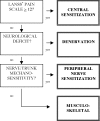Interrater reliability of a new classification system for patients with neural low back-related leg pain
- PMID: 20046553
- PMCID: PMC2700493
- DOI: 10.1179/106698109790824730
Interrater reliability of a new classification system for patients with neural low back-related leg pain
Abstract
The aim of this study was to investigate the reliability of a new classification system for low back-related leg pain arising from neural tissue dysfunction. Leg pain is a frequent accompaniment to back pain and is an indicator of the severity and prognosis of the disorder. For optimal patient care, treatment should be directed according to the identified pathophysiological mechanisms. The authors have proposed a sub-classification of neural low back-related leg pain into four categories, each requiring a different management strategy: Central Sensitization (CS), comprising major features of sensitization of the somatosensory system; Denervation (D), arising from significant axonal compromise without evidence of major central nervous system changes; Peripheral Nerve Sensitization (PNS), arising from nerve trunk inflammation without clinical evidence of significant denervation; and Musculoskeletal pain (M), referred from non-neural structures such as the disc or facet joints. The purpose of this study was to investigate the interrater reliability of this classification system. Forty consecutive patients with unilateral low back-related leg pain were independently assessed by five pairs of examiners using a physical examination protocol, screening for central sensitization of the somatosensory system, neurological deficit, and nerve tissue mechano-sensitization. Subjects were classified as follows: CS 30%, D 27.5%, PNS 10%, and M 32.5%. Interrater reliability was good with 80% agreement and a k of 0.72 (95% Confidence Interval (CI) .57-.86). The findings of the study demonstrate that patients with low back-related leg pain can be reliably classified to one of the four proposed groups.
Keywords: Classification; Interrater Reliability; Leg Pain; Low Back Pain.
Figures
Similar articles
-
Low back related leg pain: an investigation of construct validity of a new classification system.J Back Musculoskelet Rehabil. 2014;27(4):409-18. doi: 10.3233/BMR-140461. J Back Musculoskelet Rehabil. 2014. PMID: 24614828
-
Classification of low back-related leg pain--a proposed patho-mechanism-based approach.Man Ther. 2009 Apr;14(2):222-30. doi: 10.1016/j.math.2007.10.003. Epub 2007 Dec 31. Man Ther. 2009. PMID: 18165145 Review.
-
Classification of low back-related leg pain: do subgroups differ in disability and psychosocial factors?J Man Manip Ther. 2009;17(2):118-23. doi: 10.1179/106698109790824703. J Man Manip Ther. 2009. PMID: 20046554 Free PMC article.
-
The effectiveness of neural mobilizations in the treatment of musculoskeletal conditions: a systematic review protocol.JBI Database System Rev Implement Rep. 2015 Jan;13(1):65-75. doi: 10.11124/jbisrir-2015-1401. JBI Database System Rev Implement Rep. 2015. PMID: 26447008
-
Pathology and possible mechanisms of nervous system response to disc degeneration.J Bone Joint Surg Am. 2006 Apr;88 Suppl 2:68-71. doi: 10.2106/JBJS.E.01282. J Bone Joint Surg Am. 2006. PMID: 16595447 Review.
Cited by
-
Physiotherapy movement based classification approaches to low back pain: comparison of subgroups through review and developer/expert survey.BMC Musculoskelet Disord. 2012 Feb 20;13:24. doi: 10.1186/1471-2474-13-24. BMC Musculoskelet Disord. 2012. PMID: 22348236 Free PMC article. Review.
-
Re: "Interrater reliability of a new classification scheme for patients with neural low back-related leg pain" Schafer A et al. J Man Manip Ther 2009;17:109-116.J Man Manip Ther. 2009;17(4):e115-6. doi: 10.1179/106698109791352193. J Man Manip Ther. 2009. PMID: 20140147 Free PMC article. No abstract available.
-
Classification of patients with low back-related leg pain: a systematic review.BMC Musculoskelet Disord. 2016 May 23;17:226. doi: 10.1186/s12891-016-1074-z. BMC Musculoskelet Disord. 2016. PMID: 27215590 Free PMC article.
-
Sciatica: detection and confirmation by new method.Int J Spine Surg. 2014 Dec 1;8:15. doi: 10.14444/1015. eCollection 2014. Int J Spine Surg. 2014. PMID: 25694916 Free PMC article.
-
Outcomes differ between subgroups of patients with low back and leg pain following neural manual therapy: a prospective cohort study.Eur Spine J. 2011 Mar;20(3):482-90. doi: 10.1007/s00586-010-1632-2. Epub 2010 Dec 1. Eur Spine J. 2011. PMID: 21116662 Free PMC article. Clinical Trial.
References
-
- Borkan JM, Koes B, Reis S, Cherkin DC. A report from the Second International Forum for Primary Care Research on Low Back Pain: Reexamining priorities. Spine. 1998;23:1992–1996. - PubMed
-
- Van Boxem K, Van Zundert J, Van Zundert J, Patijn J, van Kleef M. Pseudoradicular and radicular low-back pain: How to diagnose clinically? Pain. 2008;135:311–312. author reply 313–315. - PubMed
-
- Leffler AS, Hansson P. Letter to the editor of Pain on Freynhagen et al: Pseudoradicular and radicular low-back pain: A disease continuum rather than different entities? Answers from quantitative sensory testing. Pain. 2007;135:65–74. - PubMed
-
- Cavanaugh JM, Weinstein JN. Low back pain: Epidemiology, anatomy and neurophysiology. In: Wall PD, Melzack R, editors. The Textbook of Pain. New York: Churchill Livingstone; 1994.
LinkOut - more resources
Full Text Sources


